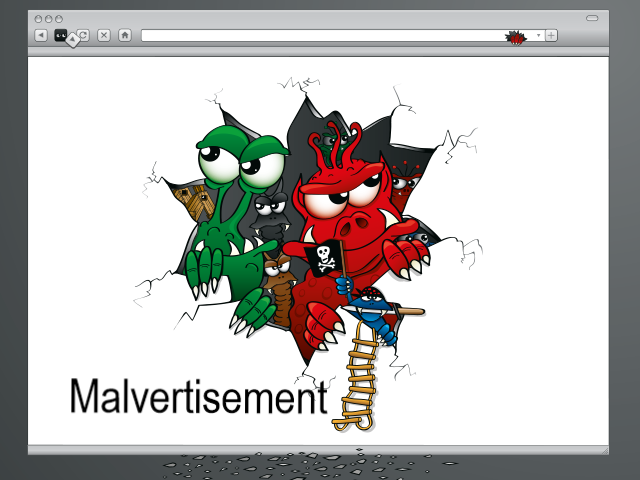You're one click away from being infected! Malvertisements
Malvertisements
or malvertising are a
malicious variety of online advertisements generally used to spread malware.
However, that definition is somewhat dated as the term has evolved. While it’s
easy to call an ad that redirects to malware a malicious one, it is often hard
to differentiate between fraudulent and legitimate online ads.
The real problem
with malvertising isn’t ads it’s vulnerable software on your system that
could be compromised by just clicking a link to a malicious website. Even if
all ads vanished from the web overnight, the core problem would remain.
Websites are hacked
every day, and assuming that your adblocker is going to protect you is a false
sense of security. If you are vulnerable, and a ton of people are, even a
single click can infect your system.
For example, there
are any number of legal online ads that any reasonable observer would
characterize as malicious or fraudulent. On the other hand, there are likely
benign ads that are flagged by some advertising networks as malicious or
fraudulent on superficially technical grounds. However, there are also vast
swaths of online ads that are completely and unquestionably malicious.
Compromised
computers can be used to create powerful botnets that can be used to
carry out identity theft, corporate espionage or other illegal activity.
Allow me to begin with the outright malicious advertisements:
The most obvious,
easily definable type of malicious advertisements are those that when clicked
on redirect users to websites that will
infect the user with malware or install some other unwanted software,
unless that person is running an antivirus product capable of blocking the
infection. Users running out-of-date operating systems and browsers are
especially vulnerable to this and other forms of malware infection.
You could visit a
newspaper’s website and an advertising script on the website would download an
ad from the ad network. The malicious advertisement would then attempt to
compromise your web browser.
This unwanted or
malicious software can serve any number of functions. If it’s malware, it could
contain a keylogger for stealing login credentials or other sensitive
data, it could pull users into a spam-spewing botnet, it could be
a banking trojan, a rogue antivirus application, ransomware like
CryptoLocker, or virtually any other type of malware that’s been written about
here or elsewhere.
A recent example is
the ad network AppNexus, who was accused of posting malvertisements on the
websites of TMZ, Java.com and others. “These websites have not been compromised
themselves, but are the victim of malvertising,” This type of malvertisement is
easy to spot and universally accepted as illegal.
That’s the core bit
of malvertising it takes advantage of flaws in software you’re using to infect
you on “legitimate” websites, eliminating the need to trick you into visiting a
malicious website. But, without malvertising, you could be infected in the same
way after just clicking a link away from that newspaper’s website. Security
flaws are the core problem here.
Now let’s
transition into the grey area:
As many have pointed
out, malvertisements don’t necessarily have to contain what is universally
considered malware. They could install tracking cookies without proper
permission to do so, they could install a legitimate piece of software without
your consent, they might clandestinely collect user information or exceed their
stated scope in some other way.
These sorts of
malicious or fraudulent online advertisements are certainly frowned upon. In
many cases, an advertising network could suspend these types of ads or require
that they be changed in order to comply with the appropriate guidelines. Some
ad networks have shady guidelines and will let nearly any type of advertising
fly.
Then
there are the legit ads that seem clearly fraudulent:
This is definitely
the hardest category, but nearly everyone will be familiar with what I am
referencing. These promote pills and tricks that can’t possibly be real and
advertise for jobs where you can make tens of thousands of dollars per month
working from home. Some claim “you’ll never believe what [some person] did!”
Others make hyperbolic references to your past being exposed online or new
rules near where you live that will affect you in some way.
Some of these kinds
of ads leads to well-meaning businesses, for sure. At the same time, a lot of
these ads straddle the line between fraud and legitimacy. In the end, someone
decides these are appropriate.
Legitimate
advertisements: Initially, a criminal may place a series of malware-free
advertisements on a trusted site that runs third-party ads and leave them alone
for several months in order to establish a good reputation. Later on, the
criminal will inject a malicious payload into the ad, infecting as
many computers as possible in a short amount of time before removing the
malicious code or discontinuing the ad. This type of attack is often run
on websites that run third-party ads.
Pop-up ads: A
pop-up ad can deliver a malicious payload as soon as the ad appears on the
viewer’s screen. Scareware, which is malicious code disguised as an
anti-virus application, is often delivered through pop-up ads. In some cases,
the malware will execute when the viewer clicks the “X” to close the pop-up
window.
By infiltrating
popular syndicated online ad services, thousands of sites can be infected at
once. Unfortunately, websites that run third-party ads can do little to protect
their visitors because syndicated ads are not under their direct control. In
fact, the company from whom they receive the ads may use ads from other
publishers, so the original source of the advertisements can be several parties
removed.
Malvertisement
infections are becoming so prevalent that many security experts recommend that
users block all pop-up ads and create an application whitelist that will only
allow their computer to run programs that have been positively approved.
How do
you protect yourself?
Don’t click on
shifty looking ads, even if they boast pictures of attractive people, issue
seemingly relevant warnings or offer fast money and magic pills. My personal
recommendation is that you only ever click on ads for things that you would
actually want to buy. If someone is offering you something with an
advertisement, then think twice, because advertisements generally attempt to
get you to buy something.
Currently, almost
all malvertising attacks take place against Windows computers. However, users
of other operating systems shouldn’t get too cocky. The recent
malvertising attack against Firefox targeted Firefox on Windows, Linux,
and Mac.
As we’ve seen
with crapware moving over to Apple’s operating system, Macs aren’t immune.
An attack on a specific web browser or a plug-in like Flash or Java
usually works the same way across Windows, Mac, and Linux.








Comments
Post a Comment